What is anaerobic soil disinfestation?
Anaerobic soil disinfestation (ASD), also known as biological or reductive soil disinfestation or soil reductive sterilization, is a nonchemical soil treatment alternative to chemical fumigation for the management of soilborne diseases, nematodes, and weeds (Blok et al. 2000; Katase et al. 2009; Momma et al. 2013; Rosskopf et al. 2015; Shinmura et al. 1999). This concept was developed in Japan (Shinmura et al. 1999) and the Netherlands (Blok et al. 2000) for small-scale farming and protected culture. Large-scale open-field research is currently underway in Florida and California to determine the effectiveness of ASD in conventional and organic crop production systems. This preplant method consists of creating anaerobic soil conditions by incorporating readily decomposable carbon (C) sources and soil amendments, irrigating the soil to field capacity, and covering the soil with gas-impermeable mulch for a period of approximately three weeks (Butler et al. 2012; Di Gioia et al. 2016; Guo et al. 2017). ASD is effective against numerous soilborne plant pathogens, plant-parasitic nematodes, and weeds because the process depletes available soil oxygen, shifts soil microbial composition to facultative anaerobes, lowers soil pH, and releases short-chain fatty acids (e.g., acetic, butyric, lactic, citric, isovaleric, and propionic acids), aldehydes, alcohols, ammonia, metal ions (Mn2+ and Fe2+), and other volatile organic compounds (Guo et al. 2018; Johns et al. 2017; Momma 2008; Momma et al. 2006; Oka 2010; van Agtmaal et al. 2015).
Different C sources, additional soil amendments, temperature, and application methods (Paudel et al. 2018) have high impacts on the success of ASD. Commonly used C sources include rice or wheat bran, green manure, molasses, and ethanol (Strauss and Kluepfel 2015). Locally available and affordable C sources are important to reduce the cost of ASD. Preplant fertilizers may be needed to stimulate microbial activity, depending on the amount of available nutrients from the C source and soil amendment (Di Gioia et al. 2017). The following ASD implementation procedure, which combines the application of composted poultry litter (CPL, soil amendment) with molasses (C source), is currently used in Florida. Yields in field trials of this method have demonstrated comparable or higher tomato marketable yield compared to standard chemical soil fumigation practices (Table 1).
Effects of soil treatments on total season marketable tomato yield (three harvests combined) in Immokalee, Florida (adapted from Guo et al. 2017).
How does one implement anaerobic soil disinfestation in field tomato production?
The implementation of ASD involves a series of steps starting with applying the treatment, then covering raised beds with totally impermeable film (TIF) and applying drip irrigation, all of which have to occur on the same day. The most common waiting period between ASD application and transplanting tomato is three weeks. After three weeks, growers can punch planting holes in the TIF and follow other normal field planting procedures.
- First Step:
Three weeks prior to transplanting, broadcast the bottom mix fertilizers (containing 10%–20%, 100%, and 10%–20% of the total season nitrogen, phosphorus, and potassium fertilizers, respectively) on the surface of the soil where beds will be located (Figure 1).
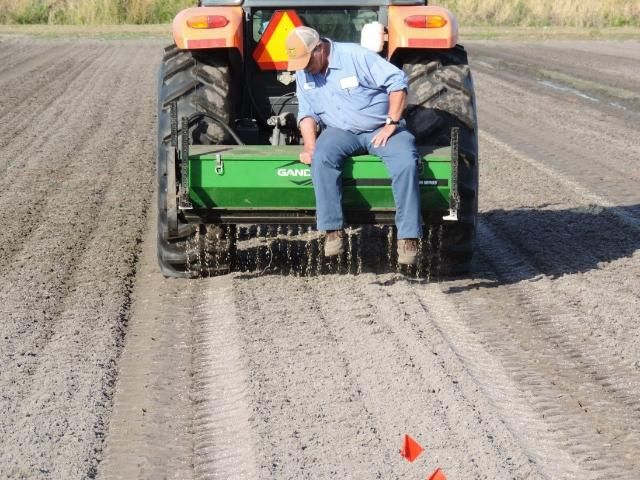
Credit: F. Di Gioia
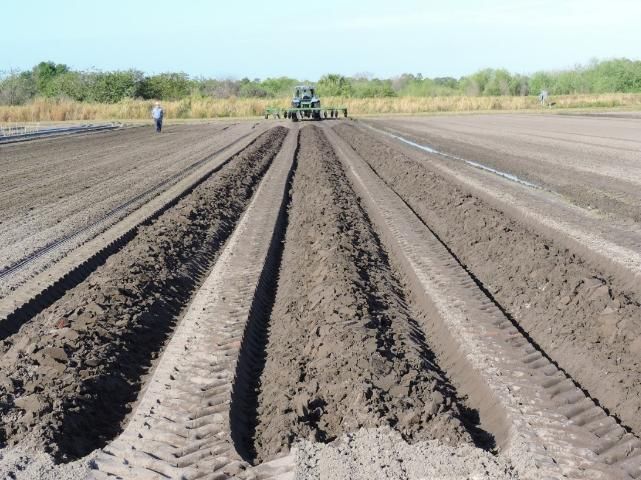
Credit: F. Di Gioia
2. Second Step:
Form the false beds approximately 4 inches high (Fig. 2) and apply CPL and molasses (Table 2; Figures 3 and 4).
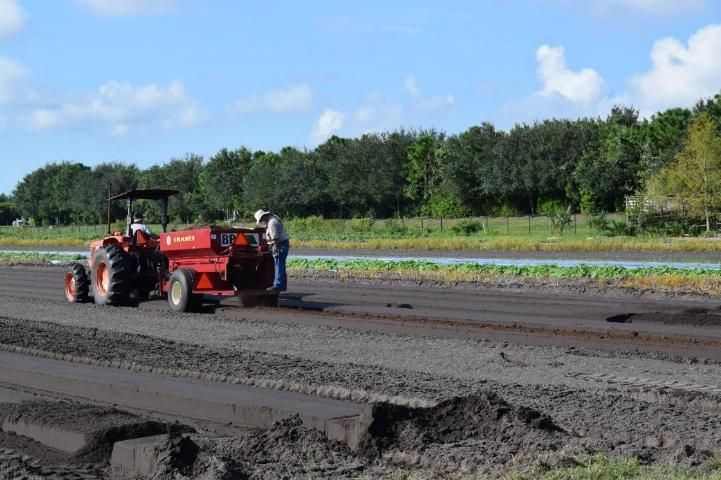
Credit: K. Sattanno, UF/IFAS
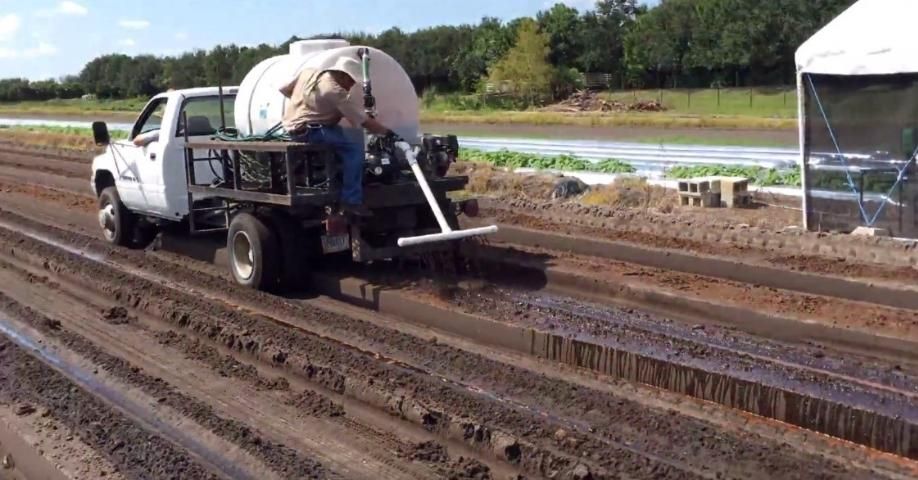
Credit: E. N. Rosskopf

Credit: F. Di Gioia
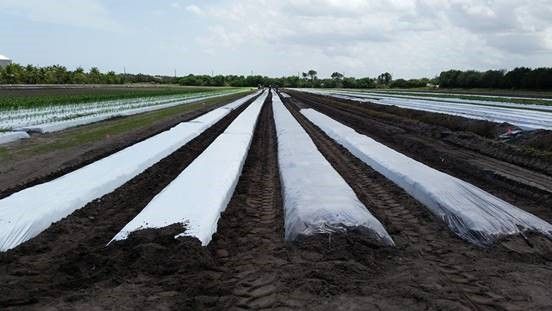
Credit: J. C. Hong
The soil amendments and C sources may be broadcast applied to the entire soil surface or banded. Soil amendments and C sources are applied only to the bed area in Florida and most locations where raised-bed systems are used. Two different methods for calculating the amount of CPL needed for ASD on a 600-foot-long and 3-foot-wide bed are given below.
- Using the broadcast application rate of composted poultry litter (4.5 tons/acre) and bed width to calculate the actual bed surface:
a) A short ton is equivalent to 2,000 lb; therefore, 4.5 tons/acre × 2,000 lb/ton = 9,000 lb/acre
b) There are 43,560 sq ft in one acre, resulting in an application rate per sq ft calculated as: 9,000 lb/acre / 43,560 sq ft/acre = 0.207 lb/sq ft
c) For a 600 ft by 3 ft bed, the actual area of the bed is 600 ft × 3 ft = 1,800 sq ft
d) This results in a total amount of material calculated as 0.207 lb/sq ft × 1,800 sq ft = 372 lb
2. Using the linear bed feet (LBF) system, consider the bed spacing is 6 ft and the bed width is 3 ft, only half of the soil surface is treated, therefore the actual application rate of composted poultry litter to the raised beds is 2.25 tons/acre:
a) A short ton is equivalent to 2,000 lb; therefore, 2.25 tons/acre × 2,000 lb/ton = 4,500 lb/acre
b) Given that there are 43,560 sq ft in one acre and that the beds are 6 ft apart (from center to center), the LBF/acre is calculated as 43,560 sq ft/acre / 6 ft = 7,260 ft/acre
c) There are 7,260 ft/acre, the application rate per LBF is calculated as: 4,500 lb/acre / 7,260 ft/acre = 0.62 lb/ft
d) The total amount of organic material required is calculated as 0.62 lb/ft × 600 ft = 372 lb
3. Fourth Step:
Irrigate the soil with 2 acre-inches of water (approximately 4–5 hours using two drip lines with 0.65 gpm/100 ft at 10 psi) to fill the pore space. The irrigation amount can be calculated as follows:
a) Water requirement for a 600-foot-long and 3-foot-wide bed (600 ft × 3 ft = 1,800 sq ft): 1,800 sq ft × 2 inches × 0.0833 ft/inch) = 299.88 cubic ft = 2,243.1 gals
b) The flow rate of the drip tape at 10 psi is 0.65 gpm/100 ft (0.0065 gpm/ft); therefore, to irrigate a 600-foot-long bed the flow requirement is: 0.0065 gpm/ft × 600 ft × 2 drip lines = 7.8 gpm
c) Thus, the time needed to run the irrigation will be: 2,243.1 gals/7.8 gpm = 288 minutes = 4.8 hours
Acknowledgements
The authors acknowledge the Areawide Project on ASD funded by USDA, Agricultural Research Service. For updated information about ASD in Florida, including publications, presentations, and reports, visit https://floridafoodandag.com/new-home/anaerobic-soil-disinfestation-asd
References
Blok, W. J., J. G. Lamers, A. J. Termorshuizen, and G. J. Bollen. 2000. "Control of Soilborne Plant Pathogens by Incorporating Fresh Organic Amendments Followed by Tarping." Phytopath. 90: 253–259. https://apsjournals.apsnet.org/doi/10.1094/PHYTO.2000.90.3.253
Butler, D. M., N. Kokalis-Burelle, J. Muramoto, C. Shennan, T. G. McCollum, and E. N. Rosskopf. 2012. "Impact of Anaerobic Soil Disinfestations Combined with Soil Solarization on Plant-Parasitic Nematodes and Introduced Inoculum of Soilborne Plant Pathogens in Raised-Bed Vegetable Production." Crop Prot. 39: 33–40. https://www.sciencedirect.com/science/article/pii/S0261219412000804
Di Gioia, F., M. Ozores-Hampton, J. Hong, N. Kokalis-Burelle, J. Albano, X. Zhao, Z. Black, Z. Gao, C. Wilson, J. Thomas, K. Moore, M. Swisher, H. Guo, and E. N. Rosskopf. 2016. "The Effects of Anaerobic Soil Disinfestation on Weed and Nematode Control, Fruit Yield, and Quality of Florida Fresh-Market Tomato." Hortscience 51: 703–711. https://journals.ashs.org/hortsci/view/journals/hortsci/51/6/article-p703.xml
Di Gioia, F., M. Ozores-Hampton, X. Zhao, J. Thomas, P. Wilson, Z. Li, J. Hong, J. Albano, M. Swisher, and E. N. Rosskopf. 2017. "Anaerobic Soil Disinfestation Impact on Soil Nutrients Dynamics and Nitrous Oxide Emissions in Fresh-Market Tomato." Agr. Ecosyst. Environ. 240: 194–205. https://www.sciencedirect.com/science/article/pii/S0167880917300889
Guo, H., F. Di Gioia, X. Zhao, M. Ozores-Hampton, M. E. Swisher, J. Hong, N. Kokalis-Burelle, A. N. DeLong, and E. N. Rosskopf. 2017. "Optimizing Anaerobic Soil Disinfestation for Fresh Market Tomato Production: Nematode and Weed Control, Yield, and Fruit Quality." Scientia Hort. 218: 105–116. https://www.sciencedirect.com/science/article/pii/S0304423817300857
Guo, H., X. Zhao, E. N. Rosskopf, F. Di Gioia, J. Hong, and D. H. McNear Jr. 2018. "Impacts of Anaerobic Soil Disinfestation and Chemical Fumigation on Soil Microbial Communities in Field Tomato Production System." Appl. Soil Ecol. 126: 165–173. https://www.sciencedirect.com/science/article/pii/S092913931730481X
Johns, C., A. Lee, T. Springer, E. N. Rosskopf, J. C. Hong, W. Turechek, N. Kokalis-Burelle, and N. Finley. 2017. "Using NMR-based Metabolomics to Monitor the Biochemical Composition of Agricultural Soils: A Pilot Study." Eur. J. Soil Biol. 83: 98–105. https://www.sciencedirect.com/science/article/pii/S1164556317302650
Katase, M, C. Kubo, S. Ushio, E. Ootsuka, T. Takeuchi, and T. Mizukubo. 2009. "Nematicidal Activity of Volatile Fatty Acids Generated from Wheat Bran in Reductive Soil Disinfestation." Nematol. Res. 39: 53–62. https://www.jstage.jst.go.jp/article/jjn/39/2/39_2_53/_article
Momma, N. 2008. "Biological Soil Disinfestation (BSD) of Soilborne Pathogens and Its Possible Mechanisms." Jpn. Agr. Res. Q. 42: 7–12. https://www.jstage.jst.go.jp/article/jarq/42/1/42_7/_article
Momma, N., K. Yamamoto, P. Simandi, and M. Shishido. 2006. "Role of Organic Acids in the Mechanisms of Biological Soil Disinfestation (BSD)." J. Gen. Plant Pathol. 72: 247–252. https://link.springer.com/article/10.1007/s10327-006-0274-z
Momma, N., Y. Kobara, S. Uematsu, N. Kita, and A. Shinmura. 2013. "Development of Biological Soil Disinfestations in Japan." Appl. Microbiol. Biot. 97: 3801–3809. https://link.springer.com/article/10.1007%2Fs00253-013-4826-9
Oka, Y. 2010. "Mechanisms of Nematode Suppression by Organic Soil Amendments—A Review." Appl. Soil Ecol. 44: 101–115. https://www.sciencedirect.com/science/article/pii/S0929139309001942
Paudel, B. R., F. Di Gioia, X. Zhao, M. Ozores-Hampton, J. C. Hong, N. Kokalis-Burelle, C. Pisani, and E. N. Rosskopf. 2018. "Evaluating Anaerobic Soil Disinfestation and Other Biological Soil Management Strategies for Open-Field Tomato Production in Florida." Renew. Agr. Food Syst. 1–12. https://doi.org/10.1017/S1742170518000571
Rosskopf, E., P. Serrano-Pérez, J. Hong, U. Shrestha, M. C. Rodríguez-Molina, K. Martin, N. Kokalis-Burelle, C. Shennan, J. Muramoto, and D. Butler. 2015. "Anaerobic Soil Disinfestation and Soil Borne Pest Management." In Organic Amendments and Soil Suppressiveness in Plant Disease Management; Soil Biology Vol 46, edited by Meghvansi and Varma. 277–305. Springer. https://link.springer.com/chapter/10.1007/978-3-319-23075-7_13
Shinmura, A., N. Sakamoto, and H. Abe. 1999. "Control of Fusarium Root Rot of Welsh Onion by Soil Reduction." (Abstract in Japanese). Jpn. J. Phytopathol. 65: 352–353.
Strauss, S. L., and D. A. Kluepfel. 2015. "Anaerobic Soil Disinfestation: A Chemical-Independent Approach to Pre-plant Control of Plant Pathogens." J. Integr. Agr. 14: 2309–2318. https://www.sciencedirect.com/science/article/pii/S2095311915611182
van Agtmaal, M., G. J. van Os, W. G. Hol, M. P. J. Hundscheid, W. T. Runia, C. A. Hordijk, and W. de Boer. 2015. "Legacy Effects of Anaerobic Soil Disinfestation on Soil Bacterial Community Composition and Production of Pathogen-Suppressing Volatiles." Front. Microbiol. 6: 1–12. https://www.frontiersin.org/articles/10.3389/fmicb.2015.00701/full